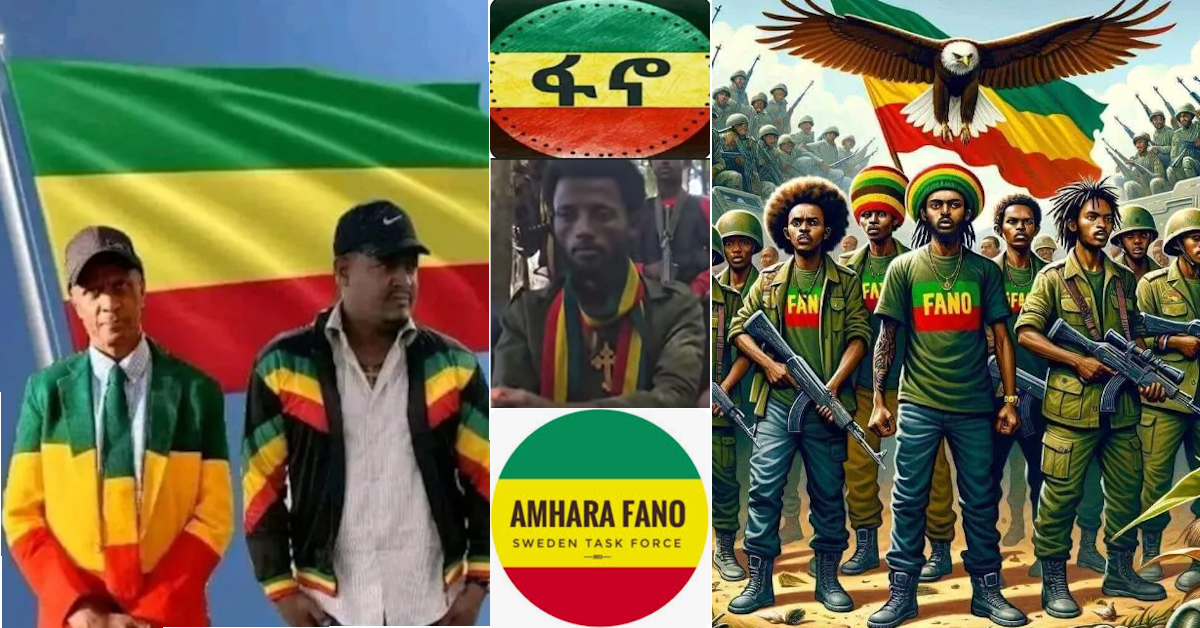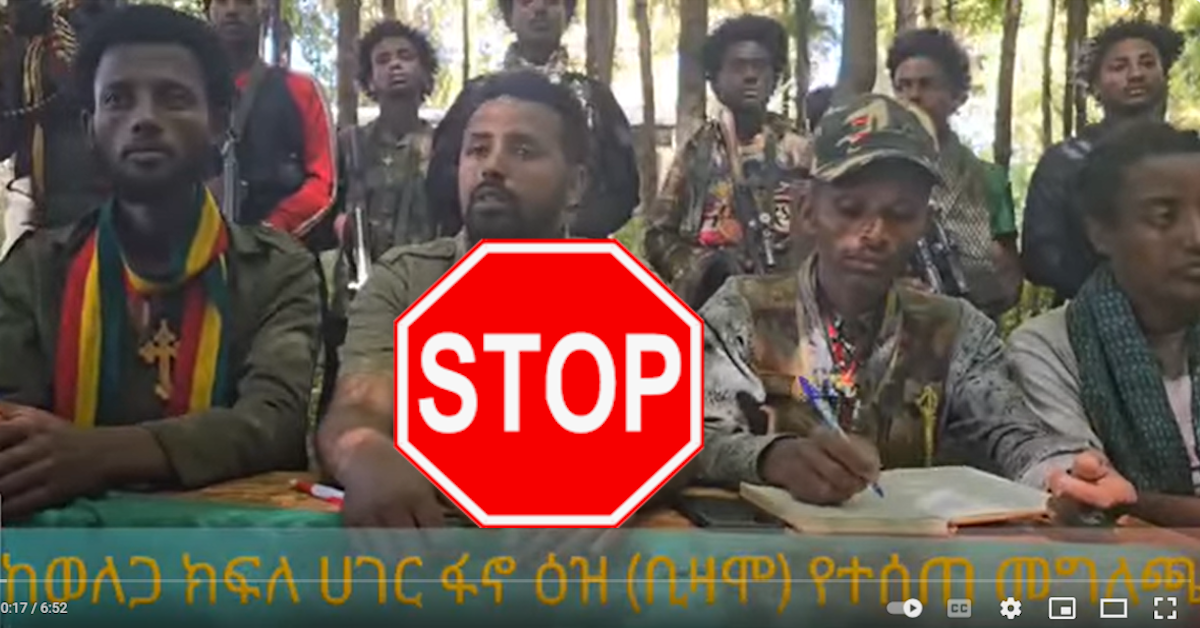The premise stated in the title requires little effort to substantiate, as the evidence speaks for itself.
1. Historical Context: A Flag Rooted in Division
The Ethiopian tricolor flag traces its origins to the reign of Emperor Yohannes IV (1872–1889), though it became more widely recognized during the reign of Emperor Menelik II in the late 19th century. Menelik, a controversial historical figure, is revered by most Amhara elites as a saint while being condemned by others, especially from marginalized groups, as a perpetrator of unimaginable atrocities. He is accused of committing acts of massacre against the Oromo and other oppressed nations, nationalities, and peoples of the Ethiopian empire. These actions were part of a campaign to consolidate Abyssinia’s southern territories into what is now Ethiopia.
This dichotomy in Menelik’s legacy—viewed as a unifying leader by one group and a murderer by another—epitomizes the polarization in Ethiopian politics. There is no neutral ground between those who celebrate Menelik and those who condemn him, making the flag a divisive rather than unifying symbol.
2. A Flag of Amhara Nationalism, Not Collective Identity
While Amhara elites passionately venerate the tricolor flag (without the EPRDF star emblem), the sentiment is far from universal. A significant majority—arguably over 75% of the population—are either indifferent or openly averse to this flag. For Amhara nationalists, the flag is not merely a national emblem but a nostalgic nod to the Menelik era. They go to great lengths to showcase this allegiance, incorporating the flag’s colors into their attire, accessories, and even personal insignia, such as armbands and headbands.
In stark contrast, non-Amhara groups, such as the Oromo people, focus on celebrating their distinct cultures and symbols including meaningful colors. This divergence underscores the flag’s role as a marker of Amhara identity rather than a symbol of unity. Its prominence in Amhara communities alone reveals its limited appeal across Ethiopia’s diverse populations.
3. The Ethiopian Orthodox Church and the Ethiopian Flag
The Ethiopian Orthodox Church (EOC), ostensibly neutral in state affairs and politics, has, in practice, become a prominent proponent of the Menelik-era flag. The Church adorns its tops and walls with the tri-color, symbolizing a strong alignment with the historical narrative tied to Emperor Menelik. At Orthodox celebrations like Masqal, clergy and other members of the EOC often wear attire decorated with the flag’s tri-color pattern. Additionally, it is widely known that certain extremist factions within the Church have gone so far as to elevate Emperor Menelik to near-sainthood, incorporating his praises into hymns and liturgical songs.
While the Amhara people frequently identify with the Menelik flag as a core symbol of their ethnic identity, the EOC exhibits even greater zeal in its association with this emblem. Historically, the Church wielded significant political power, enjoying royal court privileges and vast landownership during the imperial era. Its alignment with the Amhara ethnic group stems from this deep-rooted connection, as the Church’s history is intertwined with Amhara political and cultural dominance. Consequently, the EOC is often perceived as a political arm of the Amhara people, a characterization that persists to this day.
4. The Fano Paramilitary and Neo-Colonial Symbols
The modern Amhara nationalist paramilitary groups, commonly known as Amhara Fano, have adopted the tricolor flag alongside the Orthodox Christian cross as their defining emblems. These symbols, far from fostering unity, represent a neo-colonial agenda. If Amhara Fano were genuinely committed to Amhara nationalism, their focus would be on the Amhara regional flag and the boundaries of their constitutionally defined region. However, their actions suggest a broader aspiration for control and influence, reminiscent of Ethiopia’s imperialist past.
The Federal Constitution of 1995 restructured Ethiopia into multi-ethnic defined regions, including Amhara. Yet, instead of consolidating their region within these boundaries, Amhara elites seem fixated on reclaiming territories historically annexed to a multiethnic Abyssinia predating Ethiopia. This revivalist ambition starkly contradicts the progressive ethos of modern federalism.
5. Expansionist Fantasies and Historical Revisionism
Amhara elites, seemingly grappling with the loss of historical privileges, have embarked on a campaign to redraw Ethiopia’s map to their advantage. Their expansionist ambitions primarily target Oromia, a region that constitutes a significant portion of Ethiopia’s land (bar the Oromo people). In their revisionist narratives, they propose comically diminished versions of Oromia, reducing it to just the Borana zone in the south.
These fanciful maps, alongside their provocative rhetoric in extremist podcasts and discussions, reflect a delusional yearning for a bygone era. However, the Oromo people remain unimpressed. While they may appear silent, this silence is not acquiescence but a quiet dismissal of these unrealistic aspirations. The recent self-declaration of a “Wallaga Fano” only highlights the disconnect between Amhara elites’ dreams and the reality of Ethiopia’s socio-political landscape in the 21st century.
As if these efforts were not enough, extremists have resorted to renaming areas of interest with purportedly ancient names, claiming these regions were under their control several centuries ago, as if such claims confer legitimacy today. For instance, the so-called “Wallaga Fano” refers to the Wallaga area of Oromia as “Bizamo,” a name that appears to be entirely fabricated. A similar instance of historical revisionism occurred in their attempted claim over the capital, Finfinnee (also known as Addis Ababa), where the name “Barara” was contrived as its supposed ancient name. To bolster this narrative, a fairytale-like book was even authored to substantiate the claim (see reference #4 under Related Info below).
6. Interesting Historical Notes:
During Emperor Menelik II’s era, territories annexed and incorporated into Abyssinia were officially referred to as ቅኝ ግዛት (literally, “colonial rule”). This terminology reflected the imperial mindset of the time, treating the newly acquired areas as colonies. Later, under Emperor Haile Selassie, this term was rebranded as ጠቅላይ ግዛት (“general rule”) in an attempt to soften its colonial connotations.
The military regime that followed Haile Selassie’s imperial rule introduced the term ክፍለ ሀገር (literally, “sub-country”), framing these territories as administrative divisions akin to provinces. While this change attempted to mask the colonial implications of ቅኝ ግዛት, it did little to alter the actual relationship between the central authority and the regions it governed.
The verb or infinitive form ማቅናት, meaning “to colonize,” is closely related to the adjective ቅኝ in ቅኝ ግዛት (“colonial rule”). Over the years, however, this term underwent a semantic shift, acquiring a modified meaning of “to develop”. This linguistic evolution reflected the narrative promoted by colonizers, who sought to reframe their actions as developmental efforts with total disregard of the oppressive actions against subjugated peoples.
This reinterpretation persists in contemporary discourse. For example, when Amhara extremists or elites assert their claims over historically conquered territories such as Finfinnee, Shewa, or Wallaga, they often justify these claims by stating, “እኛ ያቀናነው አገር” (“…because it’s a country we developed”). This phrase, however, is synonymous with saying, “…because it’s a country we colonized”), underscoring the enduring colonial mindset embedded in such rhetoric.
7. Persistence of Colonial Terminology and Symbols in Modern Ethiopia
Since the adoption of the Federal Constitution in 1995, even the usage of the most recent revised term, ክፍለ ሀገር (“sub-country or province”), has entirely disappeared due to the redrawing of federal boundaries. Despite this constitutional shift, Amhara extremists, elites, and paramilitaries continue to audaciously use colonial-era references in their daily discourses and publications. This deliberate disregard is not merely incidental; it reflects an intentional rejection of the federal framework established in 1995.
By clinging to imperial-era political maps and language, these groups aim to undermine the legitimacy of the current federal system, which they openly oppose. Their continued use of colonial-era references in daily discourse and publications serves as both a symbolic and practical denial of the constitutional changes that have redefined Ethiopia’s political landscape.
This persistent use of colonial terminology alone serves as compelling evidence of their neo-colonial stance. Furthermore, their fixation on the Menelik-era tricolor flag in visual representations and symbols only amplifies this sentiment, underscoring a deep-rooted attachment to imperialistic ideologies.
8. A Call to Join the 21st Century
The Ethiopian tricolor flag, championed by Amhara elites and Amhara Fano paramilitary groups, is increasingly seen as a relic of an imperialist past and by no means a symbol of unity. The Amhara nationalist project, steeped in historical nostalgia, seems oblivious to the global transformation toward inclusivity and equality. This is not the 19th century, where colonial ambitions went unchecked; it is the 21st century, a time of self-determination and mutual respect among nations, nationalities, and peoples.
The imperial eras of emperors Menelik II and Haile Selassie established an empire rooted in entrenched inequality between the northern conquerors and conquered peoples of southern Ethiopia. Unfortunately, some Amhara elites and the Amhara Fano paramilitaries are striving to resurrect the unjust empire of Menelik and Haile Selassie.
It is high time for Amhara elites to abandon their neo-colonial fantasies and engage with the realities of a diverse Ethiopia. Clinging to divisive symbols an expansionist dreams will only deepen the fractures within the country, perpetuating cycles of conflict and mistrust. Instead, a genuine embrace of Ethiopia’s plurality could pave the way for a future rooted in equality and unity.
Let this be a reminder to all: the clock has moved forward, and so too must Ethiopia’s politics—shifting from imperial-era neo-colonialism rooted in the 19th century to a 21st-century model of multinational federation or confederation as a minimum standard, with conflict resolution firmly centered on inclusive political negotiations. Multi-ethnicity should not be viewed as the root of Ethiopia’s current political quagmire. On the contrary, the issue lies in the lack of political space for multiethnic freedom to thrive and for neo-colonialist sentiments to be decisively eliminated. Only by embracing diversity and creating an environment conducive to equitable representation can Ethiopia truly move forward.
9. Related Info
- ወለጋ የተከሰተው ፋኖ (ቢዛሞ ወለጋ ክፍለ ሀገር ፋኖ እዝ) ሙሉ መግለጫ — https://youtu.be/TAv1SS9nlcM
- አረበኛ ፋኖ የቆየ ሞላ — https://fb.watch/wC1aoZysol/
- One of the 21st-Century Daydream Maps of the Amhara Region, as Imagined by Overzealous Amhara Elites — https://vm.tiktok.com/ZMk6ooj1s/
- Barara (Addis Ababa’s Predecessor): Foundation, Growth, Destruction, and Rebirth (1400–1887) — a revisionist narrative aimed at asserting Amhara claims over Finfinnee (also known as Addis Ababa).


